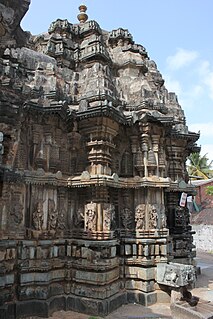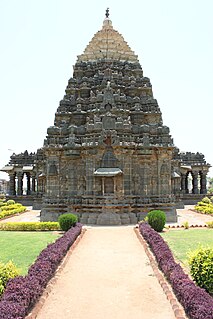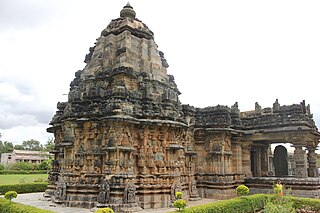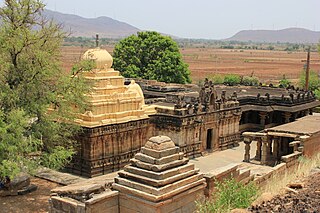
The Someshwara temple, situated in Kolar town of Karnataka state, India, is an ornate 14th century Vijayanagara era Dravidian style construction. Someshwara, another name for the Hindu god Shiva is the presiding deity in the temple. The temple is protected by the Archaeological Survey of India as a monument of national importance.

Lakshmi Narasimha Temple, dedicated to an incarnation of the Hindu god Vishnu, was built by the Hoysalas in the early 13th century. It is located in Bhadravati, an industrial town and taluk in the Shimoga District of Karnataka state, India. It is situated at a distance of about 255 km from the state capital Bangalore and at about 20 km from the district headquarters Shimoga. The art historian Adam Hardy categorizes the architectural style as a triple shrine (vimana) construction with two "exceptional" stellate forms, one for the shrine facing west and one for the shrines facing north and south, the basic building material being Soap stone. The temple stands on a jagati and the outer wall exhibits a two tier decorative plan. The monument is protected by the Karnataka state division of Archaeological Survey of India.

The Ranganthaswamy temple in Srirangapatna, in the Mandya district of Karnataka state, India, is dedicated to the Hindu god Ranganatha. It is one of the five important pilgrimage sites of Sri Vaishnavism along the river Kaveri for devotees of Ranganatha. These five sacred sites are together known as Pancharanga Kshetrams in Southern India. Since Srirangapatna is the first temple starting from upstream, the deity is known as Adi Ranga. The town of Srirangapatna, which derives its name from the temple, is located on an island in the river Kaveri.

The Mahadeva Temple is located in the town of Itagi in Yalburga Taluk, in the Koppal District of Karnataka state, India. It is about 7 km (4 mi) from Kuknur and 20 km (12 mi) from Lakkundi.

The Bucesvara temple is a simple yet elegant specimen of 12th century of Hoysala architecture. It is located in the village of Korvangla, 10 km from Hassan city, in Hassan district or Karnataka state, India. The temple was built in 1173 A.D. by a rich officer called Buci, to celebrate the coronation of Hoysala King Veera Ballala II. Nearby are two more temples that are in ruins. From the inscriptions on the premises, it is evident that these two temples had been commissioned by Buci's older brothers, Govinda and Naka. This temple is protected as a monument of national importance by the Archaeological Survey of India.

The Kalleshvara temple is located in Aralaguppe, a village in the Tiptur taluk of Tumkur district, in the Indian state of Karnataka.

The Kalleshwara temple is located in the town of Hire Hadagali of the Hoovina Hadagalitaluk in Bellary district of Karnataka state, India.

The Mallikarjuna temple is located in the town of Kuruvatti in the Bellary district of Karnataka state, India. The temple was constructed in the early 12th century rule of the Western Chalukya Empire. The temple is protected as a monument of national importance by the Archaeological Survey of India.

The Kaitabheshvara temple is located in the town of Kubatur, near Anavatti in the Shimoga district of Karnataka state, India. The temple was constructed during the reign of Hoysala King Vinayaditya around 1100 AD. The Hoysala ruling family was during this time a powerful feudatory of the imperial Western Chalukya Empire ruled by King Vikramaditya VI. According to the Archaeological Survey of India, the architectural signature of the temple is mainly "Chalukyan". Art historian Adam Hardy classifies the style involved in the construction of the temple as "Later Chalukya, non mainstream, far end of spectrum". The building material used is soapstone The temple is protected as a monument of national importance by the Archaeological Survey of India.

Kalleshvara temple is located in the town of Bagali near to Harpanahalli town in the Davangere district of Karnataka state, India.

The Nageshvara-Chennakeshava temple complex is an elegant example of Hoysala architecture of the early 12th century. It is located in the village of Mosale, about 10 km from Hassan city, in Hassan district of Karnataka state, India. The temple was built in 1200 A.D. during the reign of Hoysala King Veera Ballala II. According to art historian Gerard Foekema, the two temples that are built in the same complex, in an idyllic rural setting, form a "perfect twin". This temple complex is protected as a monument of national importance by the Archaeological Survey of India.

Kedareshwara Temple is a Hoysala era construction in the historically important town of Halebidu, in the Hassan district of Karnataka state, India. It is located a short distance away from the famous Hoysaleswara Temple. The temple was constructed by Hoysala King Veera Ballala II and his Queen Ketaladevi, and the main deity is Ishwara. The temple is protected as a monument of national importance by the Archaeological Survey of India.

Panchalingeshwara Temple in Govindanahalli, Mandya district, Karnataka state, India, was constructed around 1238 A.D. during the reign of the Hoysala empire King Vira Someshwara. The name "Panchalingeshwara" literally means "five linga". The temple is protected as a monument of national importance by the Archaeological Survey of India. The famous sculptor of Hoysala times, Ruvari Mallitamma, is known to have made contributions to the temple.

The Rameshvara temple at Koodli in the Shimoga district of Karnataka state is a Hoysala construction of the non-ornate variety and is dated to the 12th century. Koodli is a town of great antiquity and is located about 9 km north-east of Shimoga city, the district headquarters. The town gets its name because it is situated at the confluence of the Tunga and Bhadra tributaries that form the Tungabhadra river. According to art historian Adam Hardy, the temple is a single vimana with an open mantapa (hall) built with Soap stone. The temple is protected as a monument of national importance by the Archaeological Survey of India.

Akkana Basadi is a Jain temple built in 1181 A.D., during the rule of Hoysala empire King Veera Ballala II. The basadi was constructed by the devout Jain lady Achiyakka, wife of Chandramouli, a Brahmin minister in the court of the Hoysala king. The main deity of the temple is the twenty-third Jain Tirthankar Parshwanath. The temple is protected as a monument of national importance by the Archaeological Survey of India.

The Nagareshvara Temple, also called the Aravattarukmbhada Gudi is a 12th-century Western Chalaukya construction. Bankapura is located in the Haveri District of Karnataka state, India. According to the Archaeologist Henry Cousens (1854–1933), during medieval times, the Bankapura fort was considered one of the most important fortifications in the Karnataka region. According to Cousens, the temple suffered much damage when Bankapura fell to the armies of Firoz Shah Bahamani in 1406 CE and later again when it was occupied by the Bijapur Sultan Adil Shah. According to the writings of Farishtah, the Sultan "ordered a superb temple within the fort to be destroyed". However, despite much pillage, the large temple with its majestic "great" hall (mantapa) still retains some of its original beauty. That the temple was built in honor of the Hindu god Shiva comes from two short inscriptions in the temple which begin with a salutation to "Shambu". There are other inscriptions in the temple, two of which are dated 1138 CE and one dated 1091 that record grants to the god "Nagaresvaradeva". The temple is protected as a monument of national importance by the Archaeological Survey of India.

The Group of temples at Talakad, located about 45 km south-east of the culturally important city of Mysore in the Karnataka state of India are ancient Hindu temples built by multiple South Indian dynasties. Archaeological excavations of the sand dunes at Talakad have shown the existence of several ruined temples built during the rule of the Western Ganga dynasty (c.345-999). However, according to historian I. K. Sarma, only two temples, the Pataleshvara and Maraleshvara, built during the reign of King Rachamalla Satyavakya IV (r.975-986) are intact. According to the Archaeological Survey of India (ASI), the Vaidyeshvara temple, the largest, the most intact and ornate of the group bears Ganga-Chola-Hoysala architectural features. Its consecration is assignable to the 10th century with improvements made up to the 14th century. According to the art historian Adam Hardy, the Kirtinarayana temple was built in 1117 A.D. by the famous Hoysala King Vishnuvardhana to celebrate his victory over the Cholas in the battle of Talakad. It has currently been dismantled by the ASI for renovation. Only its mahadwara is intact. The Sand dunes of Talakad are protected by the Karnataka state division of the ASI. The Vaidyeshvara and Kirtinarayana temples are protected as monuments of national importance by the central Archaeological Survey of India.

The Chennakeshava temple, dedicated to the Hindu god Vishnu is located in the village of Hullekere, in the Arasikere Taluk, about 22 km from the commercial town Arasikere. It was built in 1163 A.D. by a minister of Hoysala empire king Narasimha I. The art historian Adam Hardy categorizes the architectural style as a single shrine (vimana) construction with miniature vimanas, the basic building material being Soap stone. The monument is protected by the Karnataka state division of Archaeological Survey of India.

The Bhimeshvara temple is located in the town of Nilagunda in the Davangere district of Karnataka state, India.

Govindanahalli is a small village in Mandya district of Karnataka state, southern India.
























